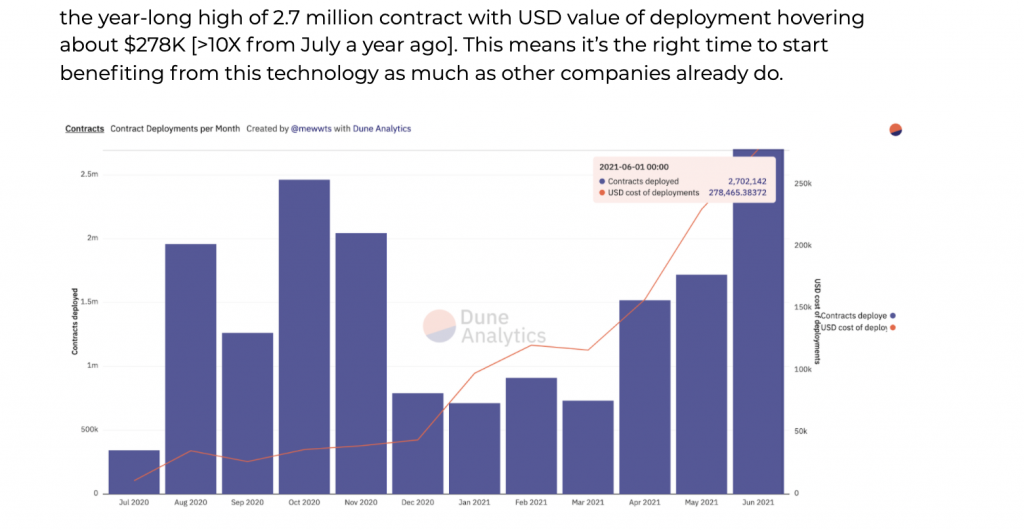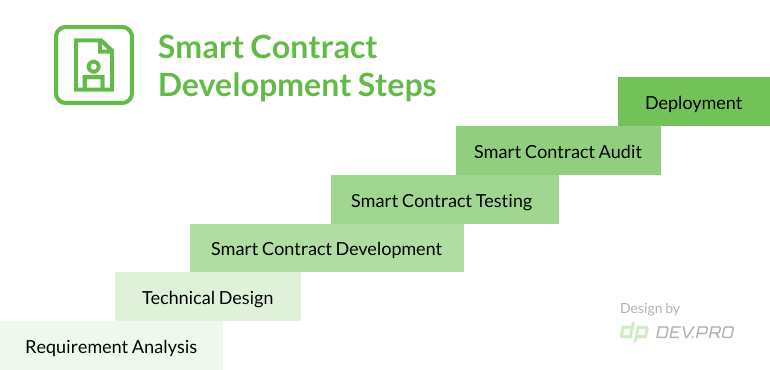At this point in the digital evolution, when most of the hype of the early crypto era has dissipated, blockchain technology is now nearly ubiquitous.
Smart contracts are a distributed technology that help automate straightforward transactions and agreements for banking, insurance, trading, employment, and real estate clients.
Why? Smart contracts are distributed, fraud-resilient, and often cheaper than alternatives.
What Is a Smart Contract?
Smart contracts are a decentralized application that encompasses, controls, and executes an agreement between two or more parties regarding a straightforward if-then transaction.
Essentially, these are pieces of code based on blockchain technology. They are not able to fully substitute the legal contracts, as they have technical limitations and programming language grammar.
Advantages of Smart Contracts Over Traditional Ones:
Smart contracts are becoming more popular because they are:
- Immutable: Smart contracts can’t be tampered with after they are signed.
- Distributed: The network government consists of multiple parties. There is no single authority that decides to include or exclude transactions from the network.
- Automated: Once the terms are set and authorized by all parties, everything happens automatically.
- Cost efficient: Commissions can be lower compared to escrow services and financial institution fees.
Just How Popular Are They?
The number of smart contracts on Ethereum has been growing for the past four months, according to Duna Analytics. In June 2021, a record 2.7 million contracts with a total value of $278K were inked (>10X from last July). This means it’s the right time to start benefiting from this technology as much as other companies already do.

Source: Dune Analytics
Let’s dive into the details.
How Smart Contracts Work and the Major Smart Contract Platforms
First things first: in 2021, Ethereum is currently the most popular platform for creating a smart contract. Most of these are coded in Solidity, which has a syntax similar to JavaScript and C++.
A software engineer with knowledge of blockchain technology and Solidity can create a smart contract based on the conditions of an automatic transaction or agreement between parties.
When the contract is signed, the system will execute it automatically based on the oracle-generated signals entering the system.
Once the conditions of the contract have been satisfied and all if-then dependencies triggered as coded, the contract is automatically terminated.
Besides Ethereum, there are other platforms designed specifically that are used to create smart contracts. Let’s investigate the key platforms.
Ethereum is still a major platform for smart contract development. With a $265 billion market cap in June 2021, the growth is phenomenal from $7 billion in April of 2017. Eth2 updates, which will occur between 2022-2024, are expected to make the platform more scalable, secure, and sustainable.
Polkadot is another popular platform for smart contracts. It has a market cap of $13.2 billion.
EOS is widely considered the most centralized of the decentralised platforms. It’s built on C++ and runs on delegated proof-of-stake timestamping scheme.
Cardano is an open-source decentralized platform that also uses proof-of-stake protocols for consensus.
There are many pros and cons of these platforms. If you are wondering which one to choose, turn to DevPro. The team will help you select a platform for coding smart contracts based on your project’s needs.
Smart Contract Use Cases: Pretty Unreal
The Digital Chamber of Commerce defined a list of 12 possible applications for smart contracts in its white paper, “Smart Contracts: 12 Use Cases for Business & Beyond”:

Source: The Digital Chamber of Commerce
Let’s see some cases that came to a certain stage of implementation:
Real World Examples of Smart Contracts
Honduras’s Ministry of Agriculture entered into partnership with Delnorte and Polygon to store agricultural land records on the blockchain.
Ubuntu Energy Ledger helps address energy crises in Africa by providing a system where users can trade surplus energy with the government in a secure and transparent manner.
Ethereum Smart Contract Use Cases
Migri, the Finnish immigration service, partnered with the MONI and Mastercard to ease the life of refugees. Using the service, refugees are able to find jobs easier, receive payments, and settle their bills electronically.
Etherisk provides multiple insurance-related smart contracts for crop insurance, flight delays, and hurricane protection. It uses multiple sources to confirm the conditions like weather reports, drone and satellite images.
Smart Contract Development Steps

If you have decided that you need smart contracts to trigger activities in your business, this section will help you get started.
The blueprint below will help you code and deploy agreements. Some of the stages will vary depending on the platform you choose, but this consequence is true for a vast majority of the cases:
Requirement Analysis
Before getting into the technical details, it is essential to determine the business requirements of the project, review the existing market offering and define potential risks. This stage should result in a roadmap with clear deadlines and objectives.
Technical Design
Depending on the scope of work, the estimated volume of transactions, required time-to-market, existing infrastructure, a technical design is created, which helps companies select a platform and create an architectural design.
Smart Contract Development
At this stage, it’s necessary to connect the dots to define the smart contract’s functionality, and write the code for further testing.
Smart Contract Testing
Each smart contract will undergo manual and/or unit testing. Manual testing is used when the code is deployed to a public testnet (like Rinkeby, Ropsten). Unit tests are required to check the validity of each specific function — to ensure they work as intended and return proper results when run individually.
Smart Contract Audits
In order to validate the code’s durability against cyber attacks, guarantee bug-free execution, and adequate resource consumption, smart contracts go through the third-party audit stage (this is usually done by KPMG, Deloitte or another audit agencies). Optionally, a product owner may want to hold a bug bounty as the final stage of testing and auditing.
Deployment
In order to make a smart contract part of the blockchain network, users will need to perform a few technical steps. Theseusually include compiling the contract to bytecode, paying for the transaction, and using a script or plugin to deploy it publicly.
For example, an algorithm that is set out on Ethereum platform, requires the following steps for smart contract deployment:
- Get enough ETH in your wallet to pay for the transaction.
- Compile your contract into a bytecode so you can send it as an Ethereum transaction.
- Acquire a deployment plugin or code, like Remix.
- Send an Ethereum transaction with the compiled bytecode via Ethereum node.
- Use Tenderly to monitor your smart contract’s performance.
How to Avoid Pitfalls
Even though there are many advantages to smart contracts, their decentralized nature also carries a few risks and downsides.
The legal system is not quite ready for this technology and laws vary from country to country.
Privacy is a huge issue with the decentralized nature of this technology, which can limit its application. Hackers are always on the lookout for new ways to get their hands on cryptocurrency.
The common pitfalls that developers face when developing smart contracts include:
Call to the unknown [even though this window of opportunity was addressed, it was worth $60 million in theDAO hack, so we thought to still mention it].
Gasless send [if a callee you are sending Ether to has an expensive fallback function limit at 2300 units of gas, there’s a risk of the ether to be retained by a malicious party].
Privacy vulnerability [due to the centralized nature of the smart contract platforms, there’s no expectation of privacy as there’s a roundabout way to find out something that’s designed private].
Reentrancy attack [this vulnerability is self-explanatory: a malicious party may trigger the same fallback function repeatedly, re-entering the same path and withdrawing funds time after time]. One of the ways to counteract this when using Solidity is to use Open Zeppelin reentrancy guard script.
Insecure randomness AKA random number generator attacks [this attack is based on the logic that many random generators are not all that random due to being deterministic by nature and are easy to predict for attackers.] Defense tactics differ from special encryption systems, using hardware with stream cipher, or using truly random source for password generation.
This is only a small list of vulnerabilities that smart contract developers should be aware of.
Where Do You Start?
If your industry or business allows smart contracts to be a part of your technical infrastructure – this may be a window of opportunity. It’s because this technology can help save financial and human resources due to the high level of automation.
On the other hand, it’s critical to make sure that you have a blockchain software development team with expertise to foresee and counteract potential vulnerabilities.
Make sure your smart contract development vendor has experience and previous examples of cases in the cryptographic field.
Dev.Pro keeps our finger on the pulse of the latest technology and hires the best talent in the field for our clients. Some of the blockchain contract development services we provide include: product tracking, stock trading, intellectual property rights, digital identity management, and multi-signature accounts.
Contact our committed sales team for a brief consultation or a full-fledged commercial proposal for your specific case.

